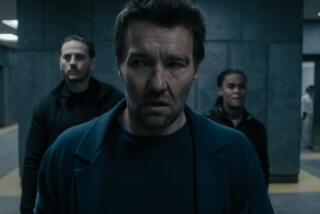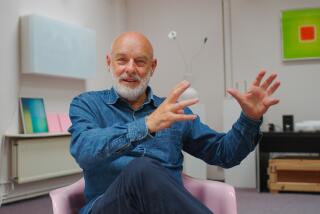‘Fabric of the Cosmos’ review: time, space and string theory
Science, which is confusing to many people — some to the point that they regard it as a form of superstition — has always needed its champions, its spokespersons, its interpreters, big brains who also function efficiently as celebrities and have a knack for taking impossible-sounding theories and making them sound, at least for the moment they’re speaking, comprehensible.
Here comes Brian Greene, again. (He is TV’s favorite theoretical physicist.) Like Carl Sagan and Stephen Hawking before him, Greene — whose “The Fabric of the Cosmos” begins a four-week run Wednesday in the framework of the PBS series “Nova” — is both mediagenic and a working scientist. You feel that he is telling you what he thoroughly knows, not stuff he had to write down to remember.
Based on Greene’s 2005 book of the same name, “The Fabric of the Cosmos” is a sequel in content and form to his 2003 Peabody Award-winning series, “The Elegant Universe,” also based on a book of the same name. I’ve seen the first two of its four episodes, dealing with space and time, two things that get more complicated the more you stare at them; the second two will look at quantum mechanics and the multiverse. The series necessarily condenses the book — a book I have partly read and have possibly partly understood — which runs 493 pages, not counting the footnotes. But your head will still be full by the time it gets done with you. Some spillage should be expected; you may need to watch it again.
Sagan, an outward-gazing astronomer whose 1980-81 series “Cosmos” was subtitled “A Personal Journey,” personified the scientist as poet: “the cosmos in which we float like a mote of dust in the morning sky” is a typical Saganism. Greene, whose main interest is subatomic string theory and the extra, invisible dimensions that are required to mathematically reconcile the differing physics of big objects and small, is by contrast a bit of a comedian, a puckish guide to places where nothing makes ordinary sense and life among the particles is a nonstop party of creation and annihilation. Even the emptiness that makes up most of the universe — if you sucked out all the space from between the atoms of the Empire State Building, we’re told, you’d have something like a grain of rice weighing hundreds of millions of pounds, which seems totally useless as a building or as rice — teems with activity.
Appropriately, the series is a busy, noisy affair, with the host now here, now there, by a river, in Times Square, in a cab, in a pool hall, digitally inserted into a space-time port of the future. (The green-screened skits can slow down Greene some; at times “Fabric” has the feel of “Blue’s Clues.”) The production makes concrete the metaphors by which the unmathematical must grasp the arcane — a discussion of time’s arrow requires an arrow, Isaac Newton’s description of space as a stage leads us to a theater. The Higgs Field, which is supposed to give particles their mass, is pictured as a crowd of paparazzi at a film premiere, lending varying weight to the major and minor celebrities whose progress it does or does not impede.
Greene and his guest brainiacs do have a tendency to speak about things like parallel planes, black holes and the end of time as if they were places one could actually hang out, an impression the accompanying computer animations reinforce. Conversely, most of us do not see ourselves as molecules, atoms or vibrating strings. The old illusions stay fast, the old metaphors still work. But it’s good, anyway, to know them for what they are.
More to Read
The complete guide to home viewing
Get Screen Gab for everything about the TV shows and streaming movies everyone’s talking about.
You may occasionally receive promotional content from the Los Angeles Times.







